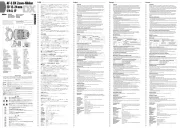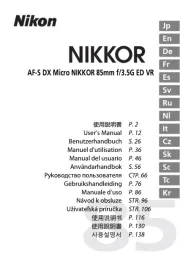Nikon Nikkor AF 24mm f/2.8D Handleiding
Bekijk gratis de handleiding van Nikon Nikkor AF 24mm f/2.8D (2 pagina’s), behorend tot de categorie Lens. Deze gids werd als nuttig beoordeeld door 7 mensen en kreeg gemiddeld 4.9 sterren uit 4 reviews. Heb je een vraag over Nikon Nikkor AF 24mm f/2.8D of wil je andere gebruikers van dit product iets vragen? Stel een vraag
Pagina 1/2

AF Nikkor
24mm
f/2.8D
使用説明書
User’s Manual
Benutzerhandbuch
Manuel d’utilisation
Manual del usuario
Manuale d’uso
使用説明書の内容が破損などによって判読できなくなったときは、ニコンサービス機関にて新しい使用説明書をお求めください(有料)。
No reproduction in any form of this manual, in whole or in part (except for brief
quotation in critical articles or reviews), may be made without written authorization
from NIKON CORPORATION.
NIKON CORPORATION
付属アクセサリー
52mmスプリング式レンズキャップ
裏ぶた
Standard accessories
52mm snap-on front lens cap
Rear lens cap
Accessoires fournis
Bouchon avant d'objectif diamètre 52 mm
Bouchon arrière
Serienmäßiges Zubehör
Aufsteckbarer Frontdeckel 52mmφ
Objektivrückdeckel
Accesorios estándar
Tapa frontal a presión de 52 mm
Tapa trasera de objetivo
Accessori in dotazione
Tappo anteriore da 52mm dia.
Tappo posteriore
Sc
Tc
52
52
Printed in Japan TT6D24 (80)
8MNJA125-24
フォーカスリング
ニコンのAF[オートフォーカス(レンズマウントにAFカップ
リングがないカメラ、F3AFを除く)]カメラとの組み合わせ
でオートフォーカス撮影ができます。また、マニュアル(手動)
によるピント合わせも可能です。さらに撮影距離情報を取り入
れたカメラとの組み合わせでは、撮影距離情報をカメラに伝達
する機能を備えています。広角レンズですので風景写真はもと
より、建築写真や狭い室内での撮影、スナップ、旅行の際の記
録写真など幅広い用途に適しています。また、遠近感が極端に
誇張されますので、特異な効果を狙った迫力のある写真が得ら
れ、近距離補正方式により近写性能も優れています。
上記以外のアクセサリーにつきましても、カメラとの組み合わせに
よりご使用できないことがあります。アクセサリーのご使用に際し
ては、必ず各カメラの使用説明書も併せてご参照ください。
レンズ表面の汚れや傷を防ぐために、NCフィルターの使用をおす
すめします。レンズの保護には、フードも役立ちますのでご使用
ください。
52mmネジ込み式フィルター
52mmネジ込みフードHN-1
CPU・AI方式のカメラでは開放測光
従来方式のカメラでは絞り込み測光
約64.5(最大径)×46mm(長さ:バヨネットマウン
ト基準面からレンズ先端まで)、全長約55.5mm
カメラへの撮影距離情報出力可能
質量
質量
質量
質量質量:
:
:
::
•Autofokusbetrieb mit entsprechend ausgerüsteten Nikon-
Autofokuskameras (außer F3AF und Kameras, die kein
Bajonett mit AF-Anschlussstück haben); manuelle
Schärfeneinstellung mit allen Nikon-Spiegelreflexkameras.
•L’autofocus est possible avec un boîtier autofocus Nikon
(sauf F3AF et les appareils photo à monture d'objectif sans
couplage AF), la mise au point manuelle avec tous les
appareils reflex Nikon.
•Es posible un funcionamiento con enfoque automático en las
cámaras de enfoque automático de Nikon (excepto F3AF y las
cámaras con monturas del objetivo sin acoplamiento AF);
aunque es posible el enfoque manual con todas las SLR de
Nikon.
●仕様、外観の一部を、改善のため予告なく変更することがあ
ります。
Änderungen von technischen Daten und Design durch den Hersteller
vorbehalten.
Les caractéristiques et le dessin sont susceptibles d’être modifiés sans préavis
ni obligation de la part du constructeur.
Las especificaciones y los diseños están sujetos a cambio sin previo aviso ni
obligación por parte del fabricante.
ニコンF6、F5、F4、F3シリーズカメラには多種類のファイン
ダースクリーンが用意されています。レンズのタイプや撮影条件に
合わせて、最適なものを選ぶことができます。このレンズに適した
ファインダースクリーンは裏の表の通りです。
(なお、ご使用に際しては必ず各カメラの使用説明書を併せてご参
照ください。)
manuel
d’ustilisation de l’apparell spécifique.
del usuario de la cámara de que se trate.
Für Nikon Kameras der Serien F6, F5, Serien F4 und
Serien F3 stehen verschiedene auswechselbare
Einstellscheiben zur Verfügung, um jedem Objectiv und
jeder Aufnahmesituation gerecht zu werden. Die für
dieses Objectiv empfohlenen werden in der Tabelle
aufgeführt (siehe Rückseite). Weitere Einzelheiten siehe
auch Benutzerhandbuch der Kamere.
ca. 64,5mm Durchmesser. x 46mm
(Länge bis zum Flansch);
Gesamtlänge ca. 55,5 mm
Thank you for purchasing the AF Nikkor 24mm
f/2.8D lens. Object distance infor
mation can
be transferred to the camera body when the
lens is used with any Nikon model with 3D
Matrix Metering capability.
•
Autofocus operation is possible with Nikon autofocus cameras
(except the F3AF and cameras with lens mounts that do not
have AF coupling); manual focus possible with all Nikon SLRs.
Important!
•Do not attach the following accessories to the lens, as they
might damage the lens CPU contacts: Auto Extension Ring
PK-1, PK-11 (use PK-11A), K1 Ring, Auto Ring BR-4, Auto
Ring BR-2 (use BR-2A) and K2 Ring.
•This lens cannot be used with the AF Finder DX-1 attached
to the Nikon F3AF camera.
Minimum aperture lock lever (Fig. A)
For programmed auto or shutter-priority auto shooting, use the
minimum aperture lock lever to lock the lens aperture at f/22.
1.Set the lens to its minimum aperture (f/22).
2.Slide the lock lever in the direction of the aperture ring so
that white dot on the tab aligns with the orange dot.
To release the lock, slide the lever in the reverse direction.
Recommended Focusing Screens
Various interchangeable focusing screens are available for
Nikon F6, F5, F4- and F3-series cameras to suit any type of
lens or picture-taking situation. Those which are
recommended for use with this lens are listed in the table
(See the reverse). For details, also refer to the specific
camera's user's manual.
Lens care
•Clean lens surface with a blower brush. To remove dirt
and smudges, use a soft, clean cotton cloth or lens tissue
moistened with ethanol (alcohol) or lens cleaner. Wipe in
a circular motion from center to outer edge, taking care
not to leave traces and not to touch the other lens parts.
•Never use thinner or benzine to clean the lens.
•To protect the lens surface from dirt or damage, the use
of an NC filter is recommended at all times. The lens
hood also helps to protect the lens.
•Attach both the front and rear lens caps when lens is not
in use.
•Do not splash water on the lens or drop it in the water
because this will cause it to rust and malfunction.
•When not using the lens for a long time, store it in a cool,
dry place to prevent mold from growing. Also store the
lens away from direct sunlight or chemicals such as
camphor or naphthalene.
•Reinforced plastic is used for some parts in the lens unit;
to avoid damage, take extra care to never leave the lens in
an excessively hot place.
Optional Accessories
52mm screw-in filters
52mm screw-in lens hood HN-1
Flexible lens pouch CL-0715
Specifications
Focal length : 24mm
Maximum aperture : f/2.8
Lens construction : 9 elements in 9 groups
Picture angle : 84
。
Distance scale : Graduated in meters and feet from 0.3m
(1.25ft) to infinity ( ).∞
Distance information: Output of object distance information to
the camera body is possible.
Aperture scale : f/2.8 to f/22 on both standard and
aperture-direct-readout scales
Minimum aperture lock
: Provided
Diaphragm : Fully automatic
Exposure measurement
:
Via full-aperture method for AI cameras
or cameras with CPU interface system;
via stop-down method for other cameras
Mount : Nikon bayonet mount
Attachment size : 52mm (P=0.75mm)
Dimensions :
Approx. 64.5mm dia. x 46mm (extension
from the camera’s lens mounting flange);
overall length is approx. 55.5mm
Weight : Approx. 270g (9.5 oz)
Specifications and designs are subject to change without
any notice or obligation on the part of the manufacturer.
Aperture ring
Meter coupling ridge
Aperture scale index (white dot)
CPU contacts
Aperture indexing post
Aperture-direct-readout scale
Aperture scale
Minimum aperture lock lever
Distance scale window
Infrared compensation index (white dot)
Distance index line
Distance scale
Lens barrel
Focus ring
Depth-of-field indicators
Fig A Minimum aperture lock lever
①
②
③
④
⑤
⑥
⑦
⑧
⑨
⑩
⑪
⑫
⑬
⑭
⑮
①
②
③
④
⑤
⑥
⑦
⑧
⑨
⑩
⑪
⑫
⑬
⑭
⑮
•Il funzionamento con messa a fuoco automatica è possibile
con le fotocamere autofocus Nikon (tranne la F3AF e le
fotocamere con innesti dell’obiettivo senza accoppiamento
AF); la messa a fuoco manuale è possibile con tutte le reflex
Nikon.
Vari schermi di messa a fuoco sono disponibili per l’uso con le
fotocamere delle Nikon F6, F5, serie F4, e serie F3 adatti a
qualsiasi tipo di obiettivo o situazione. Quelli raccomandati per
questo obiettivo sono elencati nella lista (Vedere sul retro). Per
maggiori dettagli, consultate il manuale d’uso della fotocamere.
Le specifiche e i disegni sono soggetti a modifica senza preavviso o obblighi
da parte del produttore.
Env. 64.5mm diam. x 46mm (rallonge
de la bride de montage d’objectif de
l’appareil); longueur hors-tout est env.
55,5 mm
Aprox. 64,5mm de diám. x 46mm (de
extensión desde la pestaña de
montaje del objetivo existente en la
cámara); la longitud total es de
aproximadamente 55,5mm
Ca. 64,5mm diam. x 46mm (di estensione
dalla flangia di installazione dell’obiettivo della
telecamere); lunghezza totale ca. 55,5mm
△記号は、注意(警告を含む)を促す内容を告げるものです。図の中や近くに具体的な注意内容(左図の場合は感電注
意)が描かれています。
記号は、禁止の行為(してはいけないこと)を告げるものです。図の中や近くに具体的な禁止内容(左図の場合は分解
禁止)が描かれています。
●記号は、行為を強制すること(必ずすること)を告げるものです。図の中や近くに具体的な強制内容(左図の場合は
電池を取り出す)が描かれています。
この表示を無視して、誤った取り扱いをすると、人が死亡または重傷を負う可能性が想定される内容を示しています。
この表示を無視して、誤った取り扱いをすると、人が傷害を負う可能性が想定される内容および物的損害の発生
が想定される内容を示しています。
安全上のご注意
ご使用の前に「安全上のご注意」をよくお読みのうえ、正しくお使いください。この「安全上のご注意」は製品を安全に正しく使
用していただき、あなたや他の人々への危害や財産への損害を未然に防止するために、重要な内容を記載しています。お読みにな
った後は、お使いになる方がいつでも見られる所に必ず保管してください。
表示について
表示と意味は次のようになっています。
注意
警告
注意
ぬれた手でさわらないこと
感電の原因になることがあります。
製品は幼児の手の届かないところに置くこと
ケガの原因になることがあります。
逆光撮影では、太陽を画角から充分にずらすこと
太陽光がカメラ内部で焦点を結び、火災の原因になることがあります。画角から太陽をわずかに外しても火災
の原因になることがあります。
使用しないときは、レンズにキャップをつけるか太陽光のあたらない所に保管すること
太陽光が焦点を結び、火災の原因になることがあります。
三脚にカメラやレンズを取り付けたまま移動しないこと
転倒したりぶつけたりしてケガの原因になることがあります。
窓を閉め切った自動車の中や直射日光が当たる場所など、異常に温度が高くなる場所に放置し
ないこと
内部の部品に悪い影響を与え、火災の原因となることがあります。
感電注意
放置禁止
保管注意
お守りいただく内容の種類を、次の絵表示で区分し、説明しています。
使用注意
絵表示の例
警告
分解したり、修理や改造をしないこと
感電したり、異常動作をしてケガの原因となります。
落下などによって破損し、内部が露出したときは、露出部に手を触れないこと
感電したり、破損部でケガをする原因となります。カメラの電池を抜いて、販売店またはニコンサービス
機関に修理を依頼してください。
熱くなる、煙が出る、こげ臭いなどの異常時は、速やかにカメラの電池を取り出すこと
そのまま使用すると火災、やけどの原因となります。電池を取り出す際、やけどに充分注意してください。電
池を抜いて、販売店またはニコンサービス機関に修理を依頼してください。
水につけたり、水をかけたり、雨にぬらしたりしないこと
発火したり感電の原因となります。
接触禁止
すぐに修理依頼を
分解禁止
水かけ禁止
電池を取る
すぐに修理依頼を
警告
引火、爆発のおそれのある場所では使用しないこと
プロパンガス・ガソリンなど引火性ガスや粉塵の発生する場所で使用すると、爆発や火災の原因となります。
レンズまたはカメラで直接太陽や強い光を見ないこと
失明や視力障害の原因となります。
使用禁止
見ないこと
Notes on Safety Operations
CAUTION
Do not disassemble
Touching the internal parts of the camera or lens could
result in injury. Repairs should be performed only by
qualified technicians. Should the camera or lens break
open as the result of a fall or other accident, take the
product to a Nikon-authorized service representative for
inspection after unplugging the product and/or
removing the battery.
Turn off immediately in the event of malfunction
Should you notice smoke or an unusual smell coming
from the camera or lens, remove the battery
immediately, taking care to avoid burns. Continued
operation could result in injury.
After removing or disconnecting the power source, take
the product to a Nikon-authorized service representative
for inspection.
Do not use the camera or lens in the presence of
flammable gas
Operating electronic equipment in the presence of
flammable gas could result in an explosion or fire.
Do not look at the sun through the lens or
viewfinder
Viewing the sun or other strong light sources through
the lens or viewfinder could cause permanent visual
impairment.
Keep out of reach of children
Particular care should be taken to prevent infants from
putting the batteries or other small parts into their mouths.
Observe the following precautions when handling
the camera and lens
• Keep the camera and lens unit dry. Failure to do so
could result in fire or electric shock.
•
Do not handle or touch the camera or lens unit with wet
hands. Failure to do so could result in electric shock.
• When shooting with back-lighting, do not point the
lens at the sun or allow sunlight to pass directly down
the lens as this may cause the camera to overheat and
possibly cause a fire.
• When the lens will not be used for an extended period
of time, attach both front and rear lens caps and store
the lens away from direct sunlight. Failure to do so
could result in a fire, as the lens may focus sunlight
onto a flammable object.
Hinweise für sicheren Betrieb
ACHTUNG
Keinesfalls zerlegen.
Beim Berühren der Innenteile von Kamera oder
Objektiv droht Verletzungsgefahr. Überlassen Sie
Reparaturen unbedingt ausschließlich qualifizierten
Technikern. Kommt es durch einen heftigen Stoß
(z.B. Fall auf den Boden) zu einem Bruch von
Kamera oder Objektiv, so trennen Sie zunächst das
Produkt vom Stromnetz bzw. entnehmen die
Batterie(n) und geben es dann an eine autorisierte
Nikon-Servicestelle zur Überprüfung ab.
Bei einer Störung sofort die Stromversorgung
ausschalten.
Bei Entwicklung von Rauch oder ungewöhnlichem
Geruch durch Kamera oder Objektiv entnehmen Sie
sofort die Batterie(n); dabei vorsichtig vorgehen,
denn es besteht Verbrennungsgefahr. Bei einem
Weiterbetrieb unter diesen Umständen droht
Verletzungsgefahr.
Nach dem Abtrennen von der Stromversorgung
geben Sie das Gerät an eine autorisierte Nikon-
Servicestelle zur Überprüfung ab.
Kamera oder Objektiv keinesfalls bei
Vorhandensein von brennbarem Gas einsetzen.
Wird elektronisches Gerät bei brennbarem Gas
betrieben, so droht u.U. Explosions- oder
Brandgefahr.
Keinesfalls durch Objektiv oder Sucher in die
Sonne blicken.
Beim Betrachten der Sonne oder anderer starker
Lichtquellen durch Objektiv oder Sucher droht eine
permanente Schädigung des Sehvermögens.
Dem Zugriff von Kindern entziehen.
Es ist unbedingt dafür zu sorgen, dass Kleinkinder
keine Batterien oder andere Kleinteile in den Mund
nehmen können.
Beim Umgang mit Kamera und Objektiv unbedingt die
folgenden Vorsichtmaßnahmen beachten:
•
Schützen Sie die Kamera und das Objektiv vor
Feuchtigkeit. Andernfalls droht Brand- oder
Stromschlaggefahr.
• Handhaben oder berühren Sie die Kamera bzw. das
Objektiv keinesfalls mit nassen Händen. Andernfalls
droht Stromschlaggefahr.
• Bei Gegenlichtaufnahmen nicht das Objektiv gegen die
Sonne richten oder das Sonnenlicht direkt durch das
Objektiv eintreten lassen. Dies könnte eine Überhitzung
der Kamera verursachen und ein Brand könnte die
Folge sein.
• Vor einem längeren Nichtgebrauch des Objektivs
bringen Sie den vorderen und hinteren Deckel an und
bewahren das Objektiv geschützt vor direkter
Sonnenlichteinwirkung auf. Andernfalls droht
Brandgefahr wegen möglicher Fokussierung von
Sonnenlicht durch das Objektiv auf brennbare
Gegenstände.
Remarques concernant une utilisation
en toute sécurité
ATTENTION
Ne pas démonter
Le fait de toucher aux pièces internes de l’appareil ou
de l’objectif pourrait entraîner des blessures. Les
réparations doivent être effectuées par des techniciens
qualifiés. Si l’appareil ou l’objectif est cassé suite à une
chute ou un autre accident, apportez le produit dans un
centre de service agréé Nikon pour le faire vérifier
après avoir débranché le produit et retiré les piles.
En cas de dysfonctionnement, éteignez l’appareil
immédiatement
Si vous remarquez de la fumée ou une odeur
inhabituelle se dégageant de l’appareil photo ou de
l’objectif, retirez immédiatement les piles, en prenant
soin de ne pas vous brûler. Continuer d’utiliser son
matériel peut entraîner des blessures. Après avoir retiré
ou débranché la source d’alimentation, confiez le
produit à un centre de service agréé Nikon pour le faire
vérifier.
N’utilisez pas l’appareil photo ou l’objectif en
présence de gaz inflammable
L’utilisation de matériel électronique en présence de
gaz inflammable risquerait de provoquer une explosion
ou un incendie.
Ne regardez pas le soleil dans l’objectif ou le
viseur
Regarder le soleil ou toute autre source lumineuse
violente dans l’objectif ou le viseur peut provoquer de
graves lésions oculaires irréversibles.
Tenir hors de portée des enfants
Faites extrêmement attention à ce que les enfants ne
mettent pas à la bouche les piles ou d’autres petites
pièces.
Observez les précautions suivantes lorsque vous
manipulez l’appareil et l’objectif
• Maintenez l’appareil photo et l’objectif au sec. Le
nonrespect de cette précaution peut provoquer un
incendie ou une électrocution.
• Ne manipulez pas et ne touchez pas l’appareil photo
ou l’objectif avec les mains humides. Le non-respect
de cette précaution peut provoquer une électrocution.
• Lors d’une prise de vue à contre-jour, ne dirigez pas
l’objectif vers le soleil et évitez que les rayons du soleil
pénètrent dans l’objectif ; l’appareil photo pourrait
chauffer à l’excès, ce qui risquerait de provoquer un
incendie.
• Lorsque vous n’utilisez pas l’objectif pendant une période
prolongée, fixez les bouchons avant et arrière, et rangez
l’objectif à l’abri de la lumière directe du soleil. Le non-
respect de cette précaution peut provoquer un incendie,
car l’objectif peut concentrer la lumière du soleil sur un
objet inflammable.
Notas sobre un uso seguro
PRECAUCIÓN
No desarme el equipo
El contacto con las piezas internas de la cámara o del
objetivo puede provocar lesiones. Las reparaciones
solamente deben ser ejecutadas por técnicos
cualificados. Si a causa de un golpe u otro tipo de
accidente la cámara o el objetivo se rompen y quedan
abiertos, desenchufe el producto y/o retire la batería, y
a continuación lleve el producto a un centro de servicio
técnico autorizado Nikon para su revisión.
Apague inmediatamente el equipo en caso de
funcionamiento defectuoso
Si observa que sale humo o que la cámara o el objetivo
desprenden un olor extraño, retire la batería
inmediatamente, con cuidado de no quemarse. Si sigue
utilizando el equipo corre el riesgo de sufrir lesiones.
Una vez extraída o desconectada la fuente de
alimentación, lleve el producto a un centro de servicio
técnico autorizado Nikon para su revisión.
No utilice la cámara ni el objetivo en presencia de
gas inflamable
La utilización de equipos electrónicos en presencia de
gas inflamable podría producir una explosión o un
incendio.
No mire hacia el sol a través del objetivo ni del
visor
Mirar hacia el sol u otra fuente de luz potente a través
del objetivo o del visor podría producirle daños
permanentes en la vista.
Mantener fuera del alcance de los niños
Se debe tener especial cuidado en evitar que los niños
se metan en la boca pilas u otras piezas pequeñas.
Adopte las siguientes precauciones al manipular
la cámara y el objetivo
• Mantenga la cámara y el objetivo secos. De no hacer
esto podría producirse un incendio o una descarga
eléctrica.
• No manipule ni toque la cámara ni el objetivo con las
manos húmedas. De lo contrario podría recibir una
descarga eléctrica.
• En disparos a contraluz, no apunte el objetivo hacia el
sol ni deje que la luz solar pase directamente por él, ya
que podría sobrecalentar la cámara y, posiblemente,
causar un incendio.
• Cuando el objetivo no vaya a utilizarse por un período
de tiempo prolongado, colóquele la tapa frontal y
guárdelo alejado de la luz solar directa. De no hacer
esto podría producirse un incendio, p1-ya que el objetivo
podría enfocar la luz solar directa sobre un objeto
inflamable.
移動注意
放置禁止
Note sulle operazioni di sicurezza
ATTENZIONE
Non smontare
Toccando le parti interne della fotocamera o
dell’obiettivo si potrebbero causare dei guasti. Le
riparazioni devono essere eseguite solamente da
tecnici qualificati.
Qualora, in caso di caduta o di qualsiasi altro incidente,
la fotocamera o l’obiettivo dovessero rompersi, portare il
prodotto presso un punto di assistenza Nikon
autorizzato per l’ispezione, dopo averlo disinserito dalla
presa e/o rimosso la batteria.
In caso di malfunzionamento, disattivare
immediatamente la fotocamera
Qualora dalla fotocamera o dall’obiettivo dovesse uscire
del fumo o un odore insolito, rimuovere immediatamente
la batteria, facendo attenzione a non ustionarsi.
Continuando a utilizzare la fotocamera, sussiste il
rischio di lesioni.
Dopo aver rimosso o scollegato la fonte di
alimentazione, portare il prodotto presso un punto di
assistenza Nikon autorizzato per l’ispezione.
Non usare la fotocamera o l’obiettivo in presenza
di gas infiammabili
L’utilizzo di apparecchiature elettroniche in presenza di
gas infiammabili può causare esplosioni o incendi.
Non guardare il sole in modo diretto attraverso
l’obiettivo o il mirino
Guardando in modo diretto il sole o qualsiasi altra fonte
intensa di luce, si é soggetti al rischio di indebolimento
permanente della vista.
Tenere lontano dalla portata dei bambini
Fare molta attenzione che i bambini non ingeriscano le
batterie o altre piccole parti.
Nell’utilizzo della fotocamera e dell’obiettivo,
osservare le seguenti precauzioni
• Mantenere la fotocamera e l’obiettivo asciutti. In caso
contrario si potrebbe verificare un incendio o scosse
elettriche.
• Non maneggiare né toccare la fotocamera o l’obiettivo
con le mani bagnate. In caso contrario, si potrebbero
verificare scosse elettriche.
• Durante le riprese controluce, non puntare l’obiettivo
verso il sole ed evitare che la luce solare passi
direttamente attraverso di esso, poiché la fotocamera
potrebbe surriscaldarsi ed eventualmente provocare un
incendio.
• Se si prevede di non utilizzare l’obiettivo per un
periodo prolungato di tempo, montare entrambi i tappi
di protezione e riporlo lontano dalla luce diretta del
sole. Il mancato rispetto di questa istruzione può
causare incendi, poiché l’obiettivo potrebbe
concentrare la luce del sole su un oggetto
infiammabile.

AF Nikkor
24mm
f/2.8D
Sc
Tc
52
52
付属アクセサリー
52mmスプリング式レンズキャップ
裏ぶた
Standard accessories
52mm snap-on front lens cap
Rear lens cap
Accessoires fournis
Bouchon avant d'objectif diamètre 52 mm
Bouchon arrière
Serienmäßiges Zubehör
Aufsteckbarer Frontdeckel 52mmφ
Objektivrückdeckel
Accesorios estándar
Tapa frontal a presión de 52 mm
Tapa trasera de objetivo
Accessori in dotazione
Tappo anteriore da 52mm dia.
Tappo posteriore
使用説明書
User’s Manual
Benutzerhandbuch
Manuel d’utilisation
Manual del usuario
Manuale d’uso
使用説明書の内容が破損などによって判読できなくなったときは、ニコンサービス機関にて新しい使用説明書をお求めください(有料)。
No reproduction in any form of this manual, in whole or in part (except for brief
quotation in critical articles or reviews), may be made without written authorization
from NIKON CORPORATION.
NIKON CORPORATION
当心触电
禁止放置
小心使用
妥善保存
小心移动
禁止放置
警告
注意
安全须知
有关指示
本节中标注的指示和含义如下。
表示若不遵守该项指示或操
作不当,则有可能造成人员
死亡或负重伤的内容。
表示若不遵守该项指示或操
作不当,则有可能造成人员
伤害、以及有可能造成物品
损害的内容。
禁止接触水
禁止使用
禁止观看
使用产品前请仔细阅读本使用说明书
。
请在使用前仔细阅读“安全须知”,并以
正确的方法使用。本“安全须知”中记载
了重要的内容,可使您能够安全、正确地
使用产品,并预防对您或他人造成人身伤
害或财产损失。请在阅读之后妥善保管,
以便本产品的所有使用者可以随时查阅。
本节使用以下图示和符号对必须遵守的
内容作分类和说明。
取出电池
立即委托修理
当发现产品变热、冒烟或发出焦味等
异常时,请立刻取出照相机电池。
若在此情况下继续使用,将会导致
火灾或灼伤。
取出电池时,请小心勿被烫伤。
取出电池,并委托经销商或尼康授
权的维修服务中心进行修理。
警告
切勿浸入水中或接触到水,或被
雨水淋湿。
否则将会导致起火或触电。
切勿在有可能起火、爆炸的场所
使用。
在有丙烷气、汽油等易燃性气体、
粉尘的场所使用产品,将会导致爆
炸或火灾。
切勿用镜头或照相机直接观看太
阳或强光。
否则将会导致失明或视觉损伤。
注意
切勿用湿手触碰。
否则将有可能导致触电。
切勿在婴幼儿伸手可及之处保管
产品。
否则将有可能导致受伤。
进行背光拍摄时,务必使太阳充
分偏离画角。
阳光会在照相机内部聚焦,并有可
能导致火灾。
太阳偏离画角的距离微小时,也有
可能会导致火灾。
不使用时请盖上镜头盖,或保存
在没有阳光照射处。
阳光会聚焦,并有可能导致火灾。
进行移动时,切勿将照相机或镜
头安装在三脚架上。
摔倒、碰撞时将有可能导致受伤。
切勿放置于封闭的车辆中、直射
阳光下或其它异常高温之处。
否则将对内部零件造成不良影响,
并导致火灾。
當此鏡頭與具有 3D 矩陣測光性能的尼康照相
機組合使用時﹐則具有將拍攝距離信息傳遞
進照相機內的功能
C
•與尼康自動對焦照相機一起使用時,可自
動對焦(F3AF以及鏡頭卡口不具有AF接口
的照相機除外),手動對焦適用於所有尼
康的SLR(單鏡反光)-
注意!
•由於配件會損傷鏡頭上的CPU接點﹐所以﹐
鏡頭不能接裝自動延伸環PK-1﹑PK-11﹑
K1環﹑自動環BR-4﹑自動環BR-2(但可以
使用PK-11A﹑BR-2A)和K2環-
•本鏡頭不能使用於連接自動對焦取景器着
DX-1的尼康F3AF(F3自動對焦)照相機-
最小光圈鎖定桿(請看圖A)
使用程序自動拍攝或快門優先自動拍攝﹐可
將光圈鎖定在最小光圈值(f/22)的刻度上-
1.設定鏡頭至最小光圈值(f/22)上-
2.向光圈環方向扳動最小光圈鎖定桿﹐使鎖
定桿上的白色標記對準鏡頭筒上的橙黃色
標記-
向鎖定時的反方向扳動鎖定桿即可解除鎖定-
推荐使用的對焦屏
尼康照相機F6﹑F5﹑F4系列和F3系列有各種
可互換的聚焦選擇屏 根據鏡頭的種類﹑拍-
攝環境選擇最合適的使用 下一頁的表格中-
列出了最佳於此鏡頭的對焦屏-
詳細情況請參閱該照相機的使用說明書-
使用鏡頭時的注意事項
•使用氣刷清潔鏡頭表面-萬一鏡面上沾有塵
埃污點時﹐可用柔軟清潔的綿布沾上少量的
純酒精(乙醇)或鏡面洗淨劑﹐以打圈式由
鏡頭中央向四周輕輕地邊轉邊抹 注意要均-
勻﹐不要漏擦﹐不要留下任何擦抹的痕跡-
•禁止使用輕油精或稀釋劑之類有機溶劑清
潔鏡頭-
•為避免損傷或污濁鏡頭﹐建議使用NC濾鏡-
遮光罩也能起到保護鏡頭的作用-
•不使用鏡頭時﹐請務必在鏡頭前後蓋上鏡
蓋並將鏡頭的對焦環對在無窮遠(∞)-
刻度標記上-
•注意不能濺水到鏡頭上或將鏡頭掉入水中﹐
以防止鏡頭生鏽以及發生故障-
•
為防止鏡頭長霉﹐長期不使用鏡頭時﹐請避開
高溫﹑多潮濕﹑陽光直射處以及樟腦丸或萘等
丸化學物品處應放在通風良好處保管- -
•此鏡頭有部分外殼使用強化塑料﹐在極度
高溫下可能發生變形﹐請不要放近火爐等
高溫之處-
感謝您選購自動對焦尼克爾(AF 尼克爾 24mm
f/2.8D)鏡頭 -
•運輸產品時﹐請在包裝箱內裝入足夠多的
緩沖材料﹐以減少(避免)由于沖擊導致
產品損壞-
52mm 螺旋式濾鏡
52mm 螺旋式鏡頭遮光罩 HN-1
軟鏡套 CL-0715
產品設計與規格如有更改﹐恕不另行通知
-
另售配件
規格
焦 距
最 大 光 圈
鏡 頭 構 成
畫 像 角 度
拍攝距離刻度
距 離 信 息
光 圈 值 刻 度
最小光圈鎖定桿
光 圈
曝光計測方式
鏡 頭 接 環
濾鏡附件尺寸
尺 寸
重 量
: 24mm
: f/2.8
: 9組9片
: 84°
:
以公尺和英尺從0.3m至無窮遠
(∞)級度
: 能夠顯示主體至照相機的
距離信息
: 在標準和光圈直接讀取刻
度上刻有f/2.8~f/22
: 備有
: 全自動
: 手動式自動對焦照相機全
開光圈測光﹐其他照相機
則採用縮小光圈來測光-
: 尼康卡口
: 52mm(P=0.75mm)
: 約64.5mm(直徑)×46mm
(長度﹕自照相機鏡頭卡
口邊緣算起)﹐全長約
55.5mm-
: 約270克
图示和符号的实例
符号表示禁止(不允许进行的)的
行为。
在图示中或图示附近标有具体
的禁止内容(左图之例为禁止拆解)。
符号表示唤起注意(包括警告)的内
容。在图示中或图示附近标有具体的
注意内容(左图之例为当心触电)。
●
符号表示强制执行(必需进行)的行
为。在图示中或图示附近标有具体的强
制执行内容(左图之例为取出电池)。
警告
禁止拆解
禁止触碰
立即委托修理
当产品由于跌落而破损使得内
部外露时,切勿用手触碰外露
部分。
否则将会造成触电、或由于破损
部分而导致受伤。取出照相机电
池,并委托经销商或尼康授权的
维修服务中心进行修理。
切勿自行拆解、修理或改装。
否则将会造成触电、发生故障
并导致受伤。
保留备用
尼康客户支持中心服务热线:400-820-1665
(周一至周日9:00-18:00,除夕下午休息)
http://www.nikon.com.cn/
进口商: 尼康映像仪器销售(中国)有限公司
上海市茂名南路205号瑞金大厦22楼, 200020
在日本印刷
出版日期 年 月 日: 2016 4 1
有害物质
产品中有害物质的名称及含量
部件名称
标志
外壳
光学元件
电子元件
机械元件
多溴联苯
(PBB)
铅
( )Pb
汞
( )Hg
镉
( )Cd
六价铬
(Cr(VI))
多溴二苯醚
(PBDE)
本表格依据SJ/T11364的规定编制。
: 表示该有害物质在该部件所有均质材料中的含量均在GB/T26572规定的限
量要求以下。
: 表示该有害物质至少在该部件的某一均质材料中的含量超出GB/T26572规
定的限量要求。
但是,以现有的技术条件要使照相机相关产品完全不含有上述有害物质极为困
难,并且上述产品都包含在《关于电气电子设备中特定有含物质使用限制指令
2011/65/EU》的豁免范围之内。
感謝您選購自動對焦尼克爾(AF Nikkor 24mm f/2.8D)
鏡頭。
當此鏡頭與具有立體矩陣測光性能的尼康照相機組合使
用時,則具有將攝影距離信息傳遞進照相機內的功能。
•
與尼康自動對焦相機一起使用時,可自動對焦(F3AF以及
鏡頭接環不具備AF接口的相機除外),手控對焦適用于所
有尼康的SLR(單鏡反光)。
注意!
•
由於配件會損傷鏡頭上的CPU接點,所以,鏡頭不能接裝
自動近攝環PK-1、PK-11、K1環、自動環BR-4、自動環
BR-2(但可以使用PK-11A、BR-2A)和K2環。
• 本鏡頭不能使用於連接著自動對焦取景器DX-1的尼康
F3AF(F3自動對焦)照相機。
最小光圈固定桿(請看圖A)
使用程序自動攝影或快門先決自動攝影,可將光圈環固定在
最小光圈值(f/22)的刻度上。
1.設定鏡頭至最小光圈值(f/22)上。
2.向光圈環方向扳動最小光圈固定桿,使固定桿上的白
色標記對準鏡身筒上的橙黃色標記。
向固定時的反方向扳動固定桿即可解除固定。
推荐使用的聚焦屏
尼康系列照相機F6、F5、F4和F3有各種可互換的聚焦
選擇屏。根據鏡頭的種類、拍攝的條件選擇最合適
的使
用。下一頁的表格中列出了最佳於此鏡頭的聚焦屏。
詳細情況請參閱該照相機的使用說明書。
使用鏡頭時的注意事項
•
使用氣刷清潔鏡頭表面。萬一鏡面上沾有塵埃污點時,
可用柔軟清潔的綿布沾上少量的純酒精(乙醇)或鏡
面洗淨劑,以打圈式由鏡頭中央向四周輕輕地邊轉邊
抹。注意要均勻,不要漏擦,不要留下任何擦抹的痕
跡。
• 禁止使用輕油精或稀釋劑之類有機溶劑清潔鏡頭。
• 為避免損傷或污濁鏡頭,建議使用NC濾鏡。遮光罩也
能起到保護鏡頭的作用。
• 不使用鏡頭時,請務必在鏡頭前後蓋上鏡蓋。並將鏡
頭的對焦環對在無限(∞)刻度標記上。
• 注意不能濺水到鏡頭上或將鏡頭掉入水中,以防止鏡
頭生鏽以及發生故障。
• 為防止鏡頭長霉,長期不使用鏡頭時,請避開高溫、
多潮濕、陽光直射處以及樟腦丸或 等丸化學物品處萘
。
應放在通風良好處保管。
• 此鏡頭有部分外殼使用強化塑料,在極度高溫下可能
發生變形,請不要放近火爐等高溫之處。
規 格
焦 距
最 大 光 圈
鏡 頭 構 成
畫 像 角 度
攝 影 刻 度
測距器
光圈值刻度
最小光圈固定桿
光圈率
曝 光 計 測 方 式
鏡 頭 接 環
附 件 尺 寸
體 積
重 量
﹕24mm
﹕f/2.8
﹕9組9片
﹕84
°
﹕以公尺和英尺從0.3m至無限(∞)級度
﹕能夠顯示主體至照相機的距離信息
﹕在標準和光圈直接讀取刻度上刻有
f/2.8~f/22
﹕備有
﹕全自動
﹕
手動式自動對焦照相機全開光圈測光,
其他照相機則採用縮小光圈來測光。
﹕尼康接環安裝方式
﹕52mm(P=0.75mm)
﹕
約64.5mm(直徑)×46mm(長度﹕插刀
式接環面到鏡頭前端),全長約55.5mm
﹕約270克
52mm 螺旋式濾鏡
52mm 螺旋式遮光罩 HN-1
軟鏡套 CL-0715
產品設計與規格如有更改,恕不另行通知。
另售配件
安全操作注意事項
警告
勿自行拆除
觸摸相機或鏡頭的內部零件可能會導致受傷。僅能由合
格維修技師修理。如果由於掉落或其它事故導致相機或
鏡頭拆散,在切斷產品電源和(或)取出電池後,請將
產品送至尼康授權的維修中心進行檢查。
發生故障時立刻關閉電源
如果您發現相機或鏡頭冒煙或發出異味,請立刻取出電
池,注意避免燙傷。若繼續使用可能導致受傷。
取出電池或切斷電源後,請將產品送到尼康授權的維修
中心進行檢查。
勿在易燃氣體環境中使用相機或鏡頭
如果在易燃氣體環境中使用電子設備,可能會導致爆
炸或火災。
勿通過鏡頭或觀景器觀看太陽
通過鏡頭或觀景器觀看太陽或其它強光,可能會導致永
久性的視覺損傷。
請勿在兒童伸手可及之處保管本產品
請特別注意避免嬰幼兒將電池或其它小部件放入口中。
使用相機和鏡頭時應注意以下事項
●保持相機和鏡頭乾燥。否則可能導致火災或引起電
擊。
●請勿以濕手操作或觸摸相機或鏡頭。否則可能會導致
電擊。
●背光拍攝時,請勿使鏡頭朝向太陽,或者使陽光直接
通過鏡頭,因為這可能導致相機過熱,引起火災。
●
當鏡頭長時間不用時,請蓋上鏡頭的前蓋和後蓋,並且
存放鏡頭時應避免陽光直射。否則可能會導致火災,
因為鏡頭可能會使陽光聚焦於易燃物。
光圈环
光圈指示标记(白色)
测光指示标记
CPU接点
光圈指示位
光圈直接读取刻度
光圈值刻度
最小光圈锁定杆
对焦环
距离刻度窗
镜头筒
景深指示器
距离刻度
距离刻度指示线
红外线补偿标记(白色)
①
③
④
⑤
②
图A 最小光圈锁定杆
⑥
⑦
⑧
⑨
⑩
⑪
⑫
⑬
⑭
⑮
⑨
⑩
⑪
⑫
⑬
⑭
⑮
①
②
③
④
⑤
⑥
⑦
⑧
■ファインダースクリーンとの組み合わせ表
■
Table of Recommended Focusing Screens
■Tabelle der empfohlenen Einstellscheiben
■Tableau des verres de visée recommandés
■Tabla de pantallas de enfoque recomendadas
■Tabella schermi di messa a fuoco raccomandati
■最佳对焦屏表
■
EC-B
EC-E
A/L B C E G1 G2
G3
G4
H1 H2
H3
H4
J
K/P
M R T
U/F
スクリーン
/
Screen
/
Einstellscheibe
/
Verre
/
Pantalla
/Schermo
/
对焦屏
/
F5 + DP-30
F5 + DA-30
F4 + DP-20
F4 + DA-20
F3
◎ ◎
◎
◎
◎
◎
◎
◎
◎
◎
◎
◎
(+0.5)
◎
(-1/2)
◎
(+0.5)
◎
(+0.5)
◎
(+0.5)
◎
(+0.5)
○
(+0.5)
○
(+0.5)
◎
(+0.5)
◎
◎
◎
◎
◎
◎
◎ ◎○
◎
◎
◎ ◎△
◎
◎
◎
カメラ
Camera
Kamera
Appareil
Cámara
Fotocamera
照相机
■構図の決定やピント合わせの目的には
◎: 好適です
○: 視野の一部が多少見にくくなりますが、撮影結果には全
く影響がありません。
△: スプリットの合致像は見えますが、ピント合わせは精度
上適しません。
( ): 中央部重点測光時の補正値です。F6カメラの場合、測光値
の補正は、カメラのカスタムメニュー「 スクリーン補b6
正」を「 以外」にセットして行います。 型およびBorE B E
型以外を使用する場合は、補正量が でも、「 以外」に0 BorE
セットしてください。
F5 No.18カメラの場合は、カスタムセッティング の設定で
測光値の補正を行います。F4シリーズカメラの場合は、ファ
インダースクリーン露出補正ダイヤルを回して補正を行い
ます。
詳しくはカメラの使用説明書をご覧ください。
空欄:使用不適当です。ただし、Mスクリーンの場合、撮影倍率
1/1倍以上の 影に用いられるため、この限りではあ近接撮
りません。
※上記以外のカメラで 、 、 スクリーンをご使用のB2/B3 E2/E3 K2/K3
場合は、それぞれ 、B E、Kスクリーンの欄をご覧ください。
◎= 最佳对焦
○= 可调对焦
视觉浙晕影莫尔条纹图像。但是胶卷上
的图像并不显示这一点。
△
= 可以接受的对焦
中心点的对焦图像在胶卷上可能略为散
焦。在四周的暗淡地方对焦。
( )= 显示光圈补偿值(仅在中央重点测光时)。
F6照相机通过选择自定义设定“b6∶对
焦屏补偿”中的“其他对焦屏”作补偿,
并且将曝光补偿标准设定在+/-2.0EV,
1/2EV步长。当使用了B型和E型之外的
对焦屏,“其他对焦屏”务必要选中,即
使必需的补偿值为0(没有补偿需要),
F5照相机请用机身上的“自定义设定#18”
作补偿。F4系列照相机请用对焦屏的“曝
光补偿刻度”作补偿。
详情请参阅照相机机身使用说明书。
空白=不宜使用。因为M型对焦屏可同时用
1∶1放大倍率进行宏观拍摄和微缩拍
摄,因此,不在此限。
使用B2/B3、E2/E3和K2/K3对焦屏时,请参
阅B、E和K的对焦屏一栏。
F6
■景深刻度表
Focused distance Reproduction ratioDepth of field
景深
成像比
0.3
0.35
0.4
0.5
0.7
1
2
∞
1/8.8
1/11
1/13
1/17
1/25
1/38
1/79
1/∞
f/2.8 f/4 f/5.6 f/8 f/11 f/16 f/22
0.292 —
0.308
0.338 —
0.363
0.384 —
0.418
0.473 —
0.531
0.644 —
0.769
0.882 —
1.16
1.55 —
2.84
6.46 —
∞
0.289 —
0.312
0.334 —
0.368
0.378 —
0.426
0.463 —
0.546
0.622 —
0.804
0.840 —
1.25
1.42 —
3.48
4.55 —
∞
0.285 —
0.318
0.328 —
0.377
0.369 —
0.438
0.449 —
0.567
0.597 —
0.855
0.791 —
1.38
1.27 —
4.99
3.27—
∞
0.279 —
0.326
0.319 —
0.390
0.358 —
0.457
0.431 —
0.603
0.562 —
0.949
0.728 —
1.67
1.11 —
14.8
2.31 —
∞
0.272 —
0.337
0.310 —
0.408
0.345 —
0.484
0.411 —
0.655
0.525 —
1.10
0.663 —
2.27
0.955 —
∞
1.71 —
∞
0.262 —
0.359
0.295 —
0.443
0.326 —
0.539
0.382 —
0.772
0.475 —
1.53
0.580 —
5.95
0.782 —
∞
1.20—
∞
0.251 —
0.390
0.280 —
0.498
0.307 —
0.629
0.353 —
0.996
0.428 —
3.02
0.507 —
∞
0.648 —
∞
0.894 —
∞
(m)
对焦距离
■被写界深度表
■
Profundidad de campo
■
Profundità di campo
■
Schärfentiefentabelle
■Depth of field
■
Profondeur de champ
■
Entfernung
enfoque
Schärfentiefe bei Blende
Depth of field
Depth of field
f/2.8 f/4 f/5.6 f/8 f/11 f/16 f/22
1
1.25
1.5
2
3
5
∞
1/9.0
1/12.2
1/15.3
1/21.6
1/34.1
1/59.1
1/∞
(ft)
11-5/8” —
1’5/16”
11-1/2” —
1’1/2”
11-3/8” —
1’11-1/16”
11-1/18” —
1’1-1/16”
10-13/18”
—
1’1-1/2”
10-7/16” —
1’2-3/8”
9-15/18” —
1’3-11/16”
1’2-7/16” —
1’3-9/16”
1’2-3/16”—
1’3-7/8”
1’1-7/8”—
1’4-1/4”
1’1-1/2” —
1’4-15/16”
1’1-1/16” —
1’5-7/8”
1’3/8” —
1’7-11/16”
11-5/8” —
1’10-5/8”
1’5-1/8”—
1’6-15/16”
1’4-3/4” —
1’7-7/16”
1’4-5/16”—
1’8-1/16”
1’3-3/4” —
1’9-3/16”
1’3-1/16”—
1’10-3/4”
1’2-1/8”-—
2’2-1/8”
1’1-1/8”-—
2’8-1/8”
1’10-5/16
”—
2’1-15/16”
1’9-11/16
”—
2’2-7/8”
1’8-15/16”
—
2’4-5/16”
1’7-7/8” —
2’6-3/4”
1’6-11/16
”—
2’10-5/8”
1’5-1/8”—
3’8-3/16”
1’3-9/16”—
5’7-3/4”
2’8-1/16” —
3’5-1/16”
2’6-11/16"
—
3’7-3/4”
2’5-1/16" —
4’
2’2-7/8" —
4’8-5/16”
2’11/16” —
6’1/2”
1’9-3/4” —
11’11-13/16
”
1’7-3/16” —
∞
4’1-3/8” —
6’4-7/8”
3’9-15/16"
—
7’3-11/16”
3’6-1/8" —
9’1/4”
3’1-1/2" —
14’1/2”
2’9-1/16”
—
48’11-3/8”
2’3-3/4” —
∞
1’11-7/16
”—
∞
21’2-3/8”—
∞
14’11” —
∞
10’8-3/4”—
∞
7’7-1/8”—
∞
5’7-1/8” —
∞
3’11-1/8”—
∞
2’11-3/16
”—
∞
Focused
distance
Reproduction
ratio
◎:Excellent focusing
○:Acceptable focusing
Slight vignetting affects the screen image. The
image on the film, however, shows no trace of this.
△:Acceptable focusing
The in-focus image in the central spot may prove
to be slightly out of focus on film. Focus on the
surrounding matte area.
( ):Indicates degree of exposure compensation
needed (Center-Weighted metering only). For F6
cameras, compensate by selecting "Other screen”
in Custom Setting “b6: Screen comp.” and setting
the EV level to -2.0 to +2.0 in 0.5 EV steps. When
using screens other than type B or E, “Other
screen” must be selected even when the required
compensation value is “0” (no compensation
required). For F5 cameras, compensate using
Custom Setting #18 on the camera body. For
F4-Series cameras, compensate using the Exposure
Compensation Dial for the focusing screen.
See user’s manual of the camera body for more
details.
Blank box means not applicable. Since type M
screen can be used for both macrophotography at
a 1:1 magnification ratio and for photomicrography,
it has different applications than other screens.
• When using the B2/B3, E2/E3 and K2/K3 focusing
screens in cameras other than those listed above,
refer to the columns for the B, E and K screens.
◎:
Ausgezeichnete Scharfeinstellung
○:
Brauchbare Scharfeinstellung
Das Sucherbild vignettiert leicht. Die Aufnahme selbst bleibt hiervon
unberührt.
△:
Brauchbare Scharfeinstellung.
Das im mittleren Kreis scharf eingestellte Bild könnte auf dem Film
leicht unscharf abgebildet werden. Stellen Sie auf dem umliegenden
Mattfeld scharf.
( ):
Zeigt den Betrag zusätzlich erforderlicher Belichtungskorrektur (Nur
mittenbetonte Belichtungsmessung). Bei F6-Kameras korrigieren Sie
durch Wahl von “Andere” in der Individualfunktion “b6:
Einstellscheibe” und Einstellen des LW-Werts im Bereich zwischen
–2,0 und +2,0 in 0,5-LW-Schritten. Bei Gebrauch von anderen
Scheiben als B oder E, ist “Andere” auch dann zu wählen, wenn der
erforderliche Korrekturwert “0” beträgt (keine Korrektur nötig). Zur
Einstellung des Korrekturwerts am F5 Kameragehäuse dient die
Individualfunktion Nr. 18. Mit den F4-Serien-Geräten durch den
Belichtung-Kompensationsanzeiger für Visiermattscheiben
kompensieren.
Näheres hierzu finden Sie im Benutzerhandbuch des Kameragehäuses.
Ein Leerfeld bedeutert: unbrauchbar. Da die Einstellscheibe M sowohl
für Maktrofotografie bis zum Abbildungsmaßstab 1:1 als auch
Mikrofotografie eingesetzt werden kann, unterscheidet sich ihr
Anwendungsbereich von dem anderer Einstellscheiben.
• Bei Verwendung der Scheiben B2/B3, E2/E3 und K2/K3 in anderen als den
obengenannten Kameras gelten die Spalten für die Scheiben B, E und K.
◎:
Mise au point excellente
○:
Mise au point passable
Un vignetage affecte l’image du verre. L’image sur la pellicule ne porte
cependant aucune trace de ceci.
△:
Mise au point passable
L’image mise au point dans le cercle central pourrait s’avérer
légèrement floue sur la pellicule.
La mise au point doit donc être faite sur la couronne dépolie entourant
le cercle central duverre de visée.
( ):
Indique la compensation de l’exposition additionnelle requise (Mesure
pondérée centrale uniquement). Pour les appareils F6, corrigez en
sélectionnant “Activ.: autre“ dans le réglage personnalisé "b6: Plage
visée” et en réglant le niveau IL de -2,0 à +2,0 par pas de 0,5 IL.
Lorsque vous utilisez des verres autres que ceux de type B ou E, il faut
sélectionner “Activ.: autre” même lorsque la valeur de correction est de
“0“ (pas de correction nécessaire). Pour les appareils F5, compenser
en utilisant le réglage personnalisé n 18 sur l’appareil. Pour les °
appareils de la série F4, compenser en utilisant le cadran de
compensation de l’exposition prévu pour les filtres de mise au point.
Voyez le manuel d’utilisation de l’appareil photo pour plus de détails.
Un blanc indique aucune application. Du fait que le verre M peut être
utilisé pour la macrophotographie à un rapport d’agradissement 1:1 et
pour la photomicrographie, il a des applications diffèrentes de celles
des autres verres.
• Lors de l’utilisation de verres B2/B3, E2/E3 et K2/K3 dans des appareils autres
que ceux indiqués ci-dessus, se reporter aux colonnes sur verres B, E et K.
◎:
Enfoque excelente
○:
Enfoque aceptable
Ligero viñeteo afecta la imagen de la pantalla, pero la imagen de la
película no es afectada por esto.
△:
Enfoque aceptable
La imagen enfocada en el circulo central puede resultar ligeramente
desenfocada en la fotografía. Se aconseja enfocar mediante el área
mate circundante.
( ):
Indica la cantidad de compensación adicional necesaria (Solamente
medición ponderada central). Para cámaras F6, compense
seleccionando "Otra pantalla” en el ajuste personal del usuario “b6:
Compens pantalla” y ajustando el nivel EV a -2,0 a +2,0 en pasos de
0,5 EV. Cuando se utilice una pantalla que no sea de tipo B o E, debe
seleccionarse “Otra pantalla” incluso cuando el valor de
compensación requerido sea “0” (no se requiere compensación). Para
la cámara F5 compense usando el ajuste personal del usuario No. 18
en el cuerpo de la cámara. Para las cámaras de la serie F4, compense
usando el dial de compensación de exposición para las pantallas de
enfoque.
Para más detalles, consulte el manual del usuario de la cámara.
Los blancos significan inaplicable. Como la pantalla de tipo M se usa
para macrofotografía a una razón de aumento de 1:1 asi como para
microfotografía, su aplicación es distinta a la de las demás pantallas.
• Cuando se utilicen las pantallas de enfoque B2/B3, E2/E3 y K2/K3 en
cámaras distintas de las relacionadas arriba, ver las columnas
correspondientes a las pantallas B, E y K.
◎:
Messa a fuoco eccellente
○:
Messa a fuoco accettabile
L’immagine sullo schermo presenta una riduzione di luminosità o
tracce di fenomeno del moiré. Questo però non lascia tracce sulla
pellicola.
△:
Messa a fuoco accettabile
L’immagine messa a fuoco al centro potrebbe risultare leggermente
fuori fuoco sulla pellicola. Mettere a fuoco la zona circostante il
soggetto.
( ):
Indica il valore della compensazione di esposizione aggiuntiva
richiesto (Solamente misurazione a preferenza centrale). Con le
fotocamere F6, compensare selezionando “Otra pantalla”
nell’impostazione personalizzata “b6: Compens pantalla”, quindi
impostando il livello EV tra -2.0 e +2.0 ad intervalli di 0,5 EV. Quando
si utilizzano schermate diverse da B o E, è necessario selezionare
“Otra pantalla” anche quando il valore di compensazione richiesto è
pari a “0” (nessuna compensazione necessaria). Per la fotocamera F5,
compensare utilizzando l’impostazione personalizzata 18 sul corpo
della fotocamera. Per gli apparecchi della serie F4, compensare
utilizzando il quadrante di compensazione dell’esposizione previsto
per i filtri di messa a fuoco.
Per ulteriori dettagli, fare riferimento al manuale d’uso della fotocamera.
Il quadrato vuoto non è applicabile. Come lo schermo del tipo M può
essere utilizzato per macrofotografia con rapporto di ingrandimento
1:1 e fotomicrografia, esso presenta differenti applicazioni che agli
altri schermi.
• Impiegando gli schermi B2/B3, E2/E3 e K2/K3 con fotocamere diverse da
quelle elencate sopra, fate riferimento alle rispettive colonne delle versioni
B, E e K.
距離刻度指示線
Product specificaties
| Merk: | Nikon |
| Categorie: | Lens |
| Model: | Nikkor AF 24mm f/2.8D |
Heb je hulp nodig?
Als je hulp nodig hebt met Nikon Nikkor AF 24mm f/2.8D stel dan hieronder een vraag en andere gebruikers zullen je antwoorden
Handleiding Lens Nikon
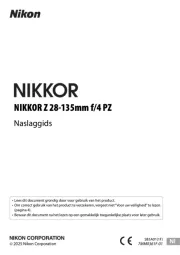
17 April 2025
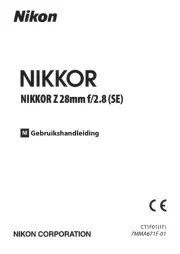
9 April 2025

27 Maart 2025

17 Maart 2025
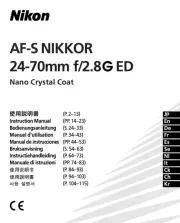
20 Februari 2025

20 Februari 2025

8 December 2024
Handleiding Lens
- Hasselblad
- Aputure
- Zeiss
- NiSi
- Axis
- Bresser
- Astera
- OM SYSTEM
- Marshall
- Gaggenau
- ECS
- Pelco
- Irix
- Angénieux
- Fujifilm
Nieuwste handleidingen voor Lens
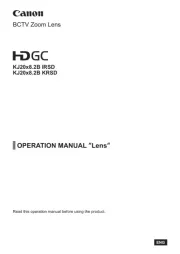
1 September 2025
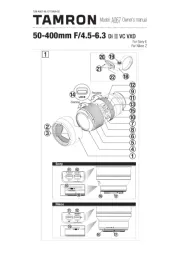
1 September 2025
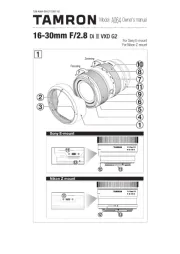
1 September 2025
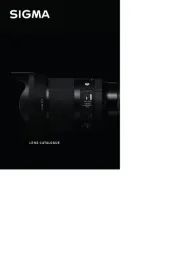
31 Augustus 2025
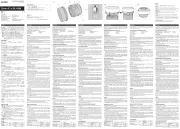
31 Augustus 2025
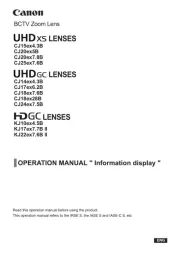
27 Augustus 2025
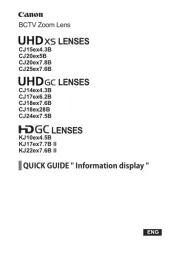
26 Augustus 2025
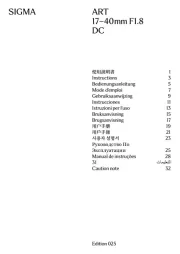
25 Augustus 2025

18 Augustus 2025

18 Augustus 2025
